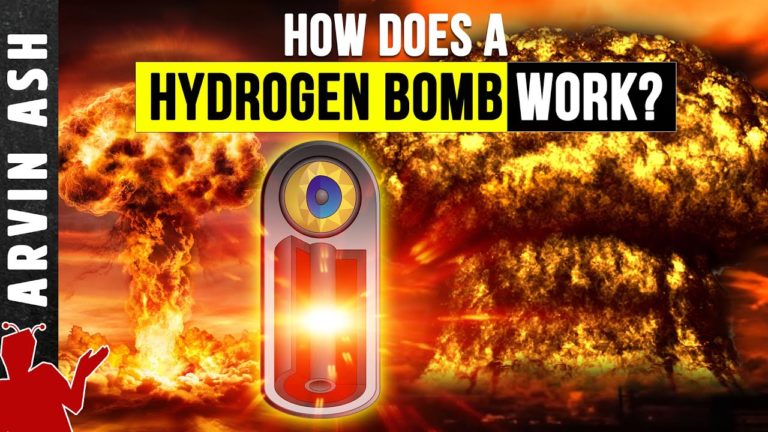Hydrogen Bomb: How it Works in detail. Atomic vs thermo nuclear bomb
Hydrogen bomb how does it work? The bomb on Hiroshima released the energy equivalent of 15,000 tons of TNT. The first hydrogen bomb released the energy equivalent of 10,000,000 tons of TNT.
While the atomic bomb like the one that was dropped on Hiroshima worked on the principle of releasing energy through the splitting of atoms – also called fission, a hydrogen bomb does something that releases even more energy, and that is it fuses atoms together.
Fusion is even more powerful than fission. It is the same process that powers our sun.
How does fusion work? The fusion bomb creates energy by combining two isotopes of hydrogen called deuterium and Tritium to create helium. A large amount of energy is released when these two isotopes fuse together to form helium because a helium atom has much less energy than these two isotopes combined. This excess energy is released in the explosion. Lithium-deuteride is what most hydrogen bombs today use as their fuel.
But how does the process of fusion actually occur? Ordinarily the nuclei of two atoms cannot be combined because these nuclei have strong positive electrical charges and repel each other. It turns out that if you increase the temperature by millions of degrees, it is possible to combine nuclei together. The temperatures needed are astronomical – higher than even that at the center of the sun – 100 million degrees Celsius.
This is when the electrons orbiting the nuclei is stripped away from the nucleus and the nuclei and electrons are floating around freely in a kind of high temperature soup. At this temperature, the nuclei can get very close to each other and the strong nuclear strong force binds the protons and neutrons together to form a helium nucleus and a free neutron.
So how is a temperature of 100 million degrees achieved? This is where the fission or atomic bomb inside the hydrogen bomb enclosure comes in. The purpose of the fission bomb is to to heat up the fusion reaction to this 100 million of degrees. A hydrogen bomb is three bombs in one – an ordinary chemical bomb, a fission bomb, and a fusion bomb. The chemical bomb initiates the fission bomb which initiates the fusion bomb.
A small atomic bomb is located at the top of the casing. The top of the sphere contains conventional chemical explosives surrounding a sphere of beryllium mirror casing, inside of which is a smaller uranium or plutonium sphere about 4 to 6 inches in diameter. Below this atomic bomb is the hydrogen or fusion bomb. It consists of a cylinder made of uranium, the fuel for the fusion reaction, lithium deuteride sits inside the cylinder. And at the core of this cylinder sits a rod of plutonium.
In between the fission and fusion bomb is Styrofoam. First, the fission bomb is detonated by exploding conventional chemical bombs in sequence, this forces the sphere of plutonium 239 or Uranium 235 to implode on itself. The implosion of this material creates a critical mass which results in an atomic explosion.
This fission explosion creates high energy gamma rays and X-rays which heat up the Styrofoam turning it into plasma. The plasma reflects off the beryllium-lined walls and focuses its energy on the fusion cylinder. These x-rays travel at the speed of light, so they reach the hydrogen fuel sooner than the physical shock wave from atomic bomb. This is important because if the shock wave reached there first, the fusion bomb would be blown apart before it could create fusion reactions.
The heat and pressure of the plasma compresses the fusion cylinder causing the lithium-deuteride to react. This releases tritium. The Tritium and deuterium fuse to form Helium and more neutrons. The neutrons cause the uranium casing and plutonium rod to undergo more fission reactions. This causes more pressure on the lithium-deuteride, producing more fusion, and releasing more neutrons which cause more fission. This positive feedback loop of fission-fusion-fission-fusion reactions goes back and forth until a huge explosion occurs ripping everything apart.
All of these events happen in about 600 billionths of a second. The result is a huge explosion. And where does all this energy come from? The sum of all atoms after the explosion would be less than the sum of all the atoms before the explosion. This mass is converted to energy using Einstein’s famous equation E=MC^2.
And exactly how much mass is converted to energy? To give you an idea, the bomb dropped on Hiroshima converted 700 miligrams of mass into energy. The total uranium used was 55 lbs. A hydrogen bomb however converts about a kilogram or 2 lbs of mass to pure energy. But in order to convert this much, you have to start with about 140 kilos or 300 lbs. of hydrogen.
Only six countries have such bombs —China, France, India, Russia, United Kingdom, and the United States.
Do not forget to share your opinion with us to provide you with the best posts !




Good site you have got here.. It’s hard to find high-quality writing like yours nowadays. I really appreciate people like you! Take care!!
You are so awesome! I don’t believe I have read a single thing like that before.
So nice to discover another peerson with some original thoughts on this subject matter.
Really.. thanks for starting this up. This website iis somethng that
iss needed on the internet, someone witth sopme originality!